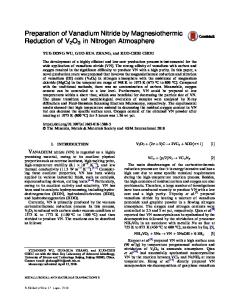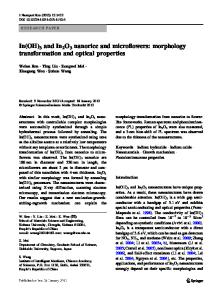High-Temperature Optical Properties of Thin-Film Vanadium Oxides - VO 2 and V 2 O 3
- PDF / 316,770 Bytes
- 6 Pages / 414.72 x 648 pts Page_size
- 71 Downloads / 346 Views
ABSTRACT Thin-film vanadium dioxide (V0 2) and vanadium sesquioxide (V2 0 3 ) undergo shear phase transformations at 340K and 120K, respectively. The electrical and infrared optical properties of these materials are dramatically impacted by this phase transformation. Below the phase transition temperature, both V0 2 and V20 3 are "poor" electrical insulators and have minimal absorption in the infrared spectral region. Above the phase transition temperature, both V0 2 and V20 3 are poor conductors and are opaque in the infrared. The infrared thermochromic properties of these materials make them interesting candidates for several optical applications. Utilization of either V0 2 or V20 3 necessitates an accurate knowledge of the optical properties both above and below the phase transition temperature. This paper reports on some recent infrared ellipsometric measurements on the optical properties of these materials above the transition temperature. These measurements found that both are strongly dispersive through the 3-12 micron spectral region. In addition, the temperature dependence of the optical properties of V0 2 above the transition temperature can be related to the film morphology and stoichiometry.
INTRODUCTION Many transition metal oxides are known to exhibit abrupt changes in physical properties with temperature."12 The most extensively studied of these are the oxides of vanadium 3 - most notably vanadium dioxide, V0 2, and vanadium sesquioxide, V20 3. These materials undergo first-order crystallographic phase transitions from low-temperature semi-conducting states to hightemperature metallic states. The interest in V0 2 and V 20 3 derives primarily from the extremely large, discontinuous changes in optical and electrical properties associated with their phase transitions. Indeed changes in 1.0 electrical resistivity as large as 105 have been reported in V0 2 single crystals over a 0.8 temperature interval of 0.1 K.4' 5 Figure 1 shows the infrared 8c 0.63V203 0.6V0 optical transmission as a function of temperature for E thin-film V0 2 and V20 3. This CE 0.4 large discontinuity in physical '" properties makes these materials extremely attractive 0.2 for electrical and optical 0 switching applications 6 .
Effective
utilization
0
100
200
300
400
of Temperature (K) these materials in high performance optical device Figure 1: Infraredtransmissionas afunction of temperature applications necessitates for thin-film V2 0 3 and V0 2. 161 Mat. Res. Soc. Symp. Proc. Vol. 479 01997 Materials Research Society
accurate knowledge of complex index of refraction, n, where n = n - jk. There have been several previous reports of the complex index of refraction for both V0 2 7' 8' 9 and V 20 3 1°'11. The majority of these have focused on V0 2 and in all cases there has been a wide range of reported values. This paper presents the results of some recent measurements taken on thin-film V0 2 and V20 3 in the metallic state using broadband infrared ellipsometry.
EXPERIMENT The optical properties of thin-film V0 2 and V 2
Data Loading...











